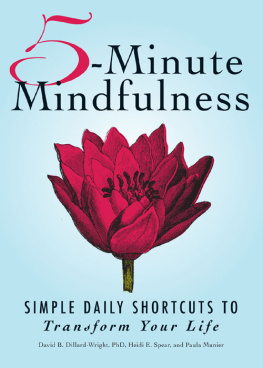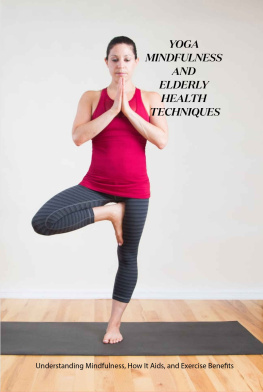-Minute
Mindfulness
SIMPLE DAILY SHORTCUTS TO
Transform Your Life
David B. Dillard-Wright, PhD, Heidi E. Spear, and Paula Munier

For Father George, my godmother Susie, and my yogini Emma.
INTRODUCTION
WHAT IS MINDFULNESS?
Yesterday is history. Tomorrow is a mystery. And today? Today is a gift. Thats why we call it the present.
B ABATUNDE O LATUNJI
Live in the present.
Be here now.
Just breathe.
Great advice, but what does it really mean? And, how do you do it? You dont live on a mountaintop, or in a cave, or even in a monastery where you can devote endless hours to gazing at your navel in pursuit of enlightenment. You live in the so-called real world, where just getting through another 24/7 day is a challenge worthy of the Buddha.
But it doesnt have to be that way. You can master the art of mindfulnessand live in the present, be here now, and just breathe. You can learn to quiet your mind, listen to your body, and reconnect with your true selfdeepening your experience of your own life.
And, you can do it anywhere, anytime. Mindfulness is a portable skill; once learned, you can carry with you and call on it whenever you need itday by day, hour by hour, moment by moment.
In this book, well show you how to cultivate mindfulness in your everyday life in only minutes a day. Youll be amazed at how being more mindful can make a difference in the way you feelbody, mind, and soul. Whats more, youll discover the keys that open the door to your potential as a human being. Youll enter a vast and beautiful dimension of universal wisdom, wisdom you can call on to meet challenges, cope with difficulties, and resolve problems. Youll also learn to engage with your own life in ways that teach, heal, and enhance everything and everyone around you. It may take some work, but it is a labor of love you deserve to give yourself.
What Is Mindfulness?
Simply put, mindfulness is paying attention to your life as you live it. Learning to pay attention to your life as you live it can sometimes be challenging. You get caught up in your conflicting emotions, you drag yourself down with baggage from the past, you worry yourself with your unhappy visions of the future. Distracted by this barrage of thoughts and feelings and memories and imaginings, you forget to notice whats happening now, right in front of you.
CHAPTER 1
LIVING A MINDFUL LIFE
You can become blind by seeing each day as a similar one. Each day is a different one, each day brings a miracle of its own. Its just a matter of paying attention to this miracle.
P AULO C OELHO
Odds are youve been practicing mindfulness all along without even knowing it. Most of us have experienced little aha! moments when were doing something else entirelywhile going for a jog, or driving to work, or even washing the dishes. Self-awareness often surprises us when we perform such simple, methodical tasks that free the mind from the seemingly endless loops of thoughts and feelings that can distract us from the moment at hand. The sort of activities that can induce such unexpected mindfulness run the gamut of human experience, including:
Sports. Athletes frequently speak of being in the zonethe mental freedom they experience when the body is completely involved in meeting a challenge, such as running a long distance or climbing a steep incline.
Mothering. Mothers know the serenity that sets in as they sing a child to sleep or rock a baby in their arms. This maternal peace can begin with breastfeeding, which not only enhances the bonding process with the infant but also deepens the perception of the life force itself.
Strenuous work. The focus required to perform vigorous physical labor, such as carrying heavy loads with great care or chopping wood, can bring uncommon mindbody awareness.
Knitting. The rhythm of the clacking needles, the feel of the soft yarn between your fingers, the persistent lull of the contiguous stitchesthats the mindmeld of knitting that lets enlightenment happen.
Gardening. Digging in the dirt not only evokes the sense of childs play we experienced as kids in the sandbox, it also puts us back in touchliterallywith Mother Earth. Both playing and communing with nature require living in the moment and are therefore mindful activities.
Chores. Familiar tasksthose so familiar that you can do them in your sleepoften create space for the mind to relax and drop into the present moment.
In these instances, it is the realizationwithout thought or feelingthat you are participating in the moment that brings you into the state of mindfulness. Learn to cultivate this state more often and for longer periods of time, and you are on your way to enlightenment.
MINDFUL YOU, HEALTHY YOU
If discovering greater meaning and purpose in life wasnt reason enough to convince us, the physical benefits of mindfulness should be. Over the past few decades, mounting scientific evidence confirms that mindfulness can reduce the harmful effects of our stressful lifestyles, making us healthier, as well as happier.
Want to have more energy?
Reduce the risk of a heart attack?
Control depression and anxiety?
Science now shows us that we dont always have to reach for a pill bottle. There are alternative means of enhancing our well-being and mindfulness is prime among them. Through various mindfulness techniquesmany centuries if not millennia oldwe can relearn the time-honored lessons lost in our fast-paced, technology-driven societies. At the same time, technology and science can help us to better understand these ancient practices, revealing how and why they actually work.
Throughout the ages, every society has created its unique set of mindfulness techniques. Many of these techniques have morphed over time, adapting to changing mors and customs. Some traditions have influenced one another in profound ways, such as yoga and Buddhism. Today, we see that same confluence happening even in secular settings. For instance, many stress-reduction programs incorporate yoga postures and Buddhist meditation techniques.
In this book, you will find a mixture of the old and the new, the scientific and the philosophic, the anecdotal and the empiricalall of which support the fact that mindfulness really does promote healthy living.
The Mindfulness Toolbox
Thanks to this wealth of knowledge and tradition, we can transform ourselves into creatures of mindfulness rather than creatures of habit. Some of the most effective old and new mindfulness tools include:
Meditation
Prayer
Yoga
Tai Chi
Deep breathing
Visualization
Massage
Reiki
Aromatherapy
Music therapy
Exercise
Hypnosis
Biofeedback
THE MANY FACES OF MINDFULNESS
There are many approaches to mindfulness. Some may appear simple, practical, and easy to understand; others may seem otherworldly, impractical, and esoteric. Some styles may have proven too religious to appeal to you or not spiritual enough.
In 5-Minute Mindfulness, youll learn how to chooseand usethe best tools for your own body, mind, and soul. To find the mindfulness approach that best addresses your individual needs, well look at what each offers and decide which features are suitablefor you. Its not necessary to limit yourself to one technique. By incorporating what reflects your unique nature, whether it is two or three styles or a dozen, you will be able to design a mindfulness practice that reflects all that you are and that encourages you to be all you can be.









